Abstract
There is increasing evidence for an important role of adverse early experience on the development of major psychiatric disorders in adulthood. Corticotropin-releasing factor (CRF), an endogenous neuropeptide, is the primary physiological regulator of the mammalian stress response. Grown nonhuman primates who were exposed as infants to adverse early rearing conditions were studied to determine if long-term alterations of CRF neuronal systems had occurred following the early stressor. In comparison to monkeys reared by mothers foraging under predictable conditions, infant monkeys raised by mothers foraging under unpredictable conditions exhibited persistently elevated cerebrospinal fluid (CSF) concentrations of CRF. Because hyperactivity of CRF-releasing neurons has been implicated in the pathophysiology of certain human affective and anxiety disorders, the present finding provides a potential neurobiological mechanism by which early-life stressors may contribute to adult psychopathology.
Full text
PDF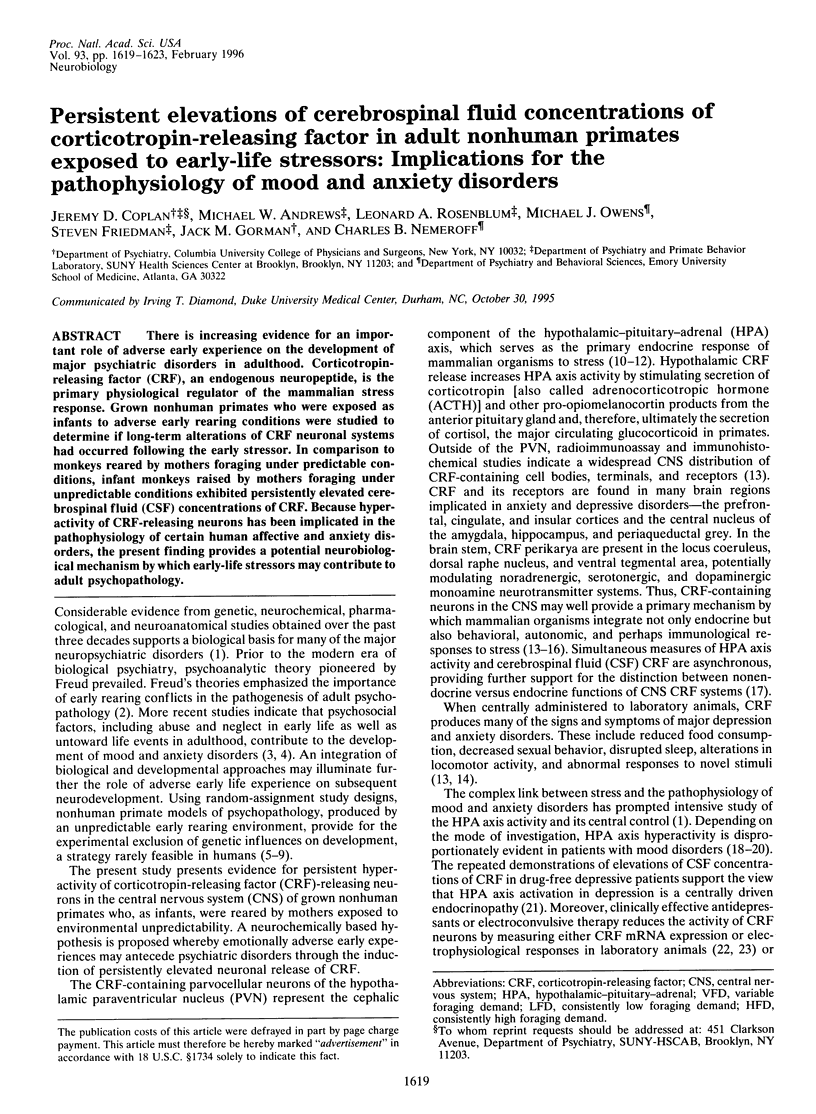
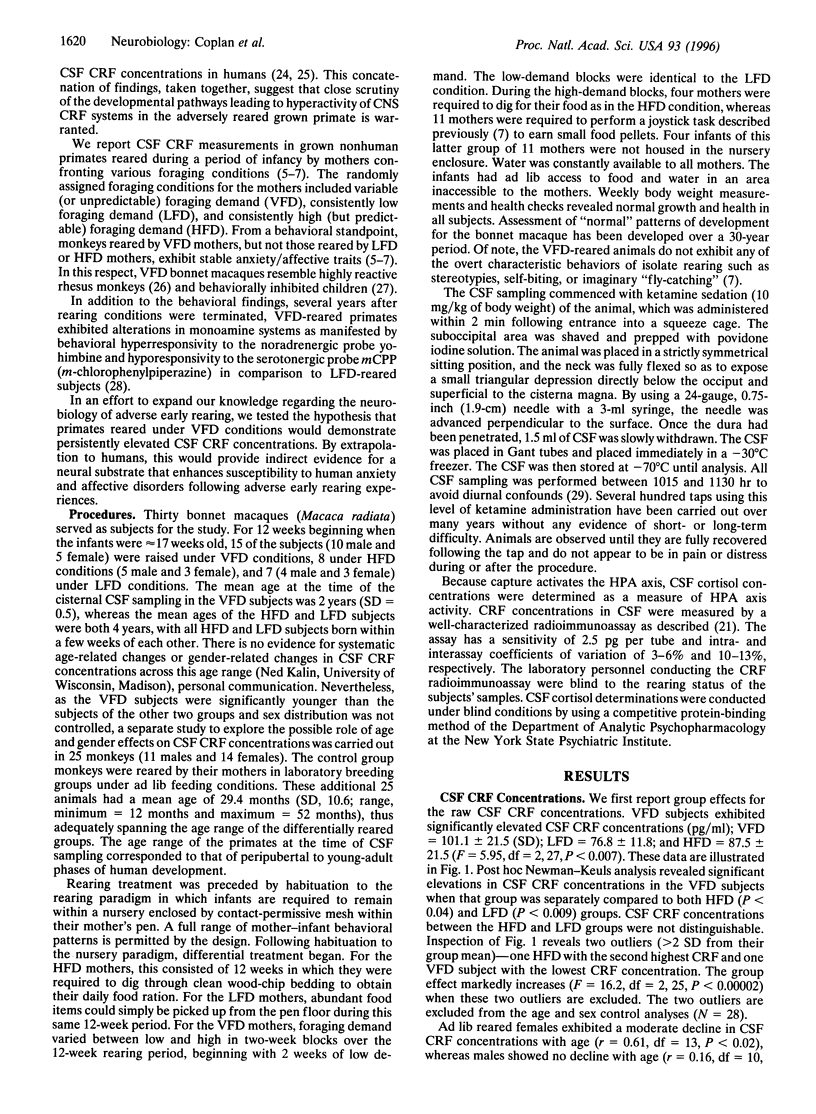
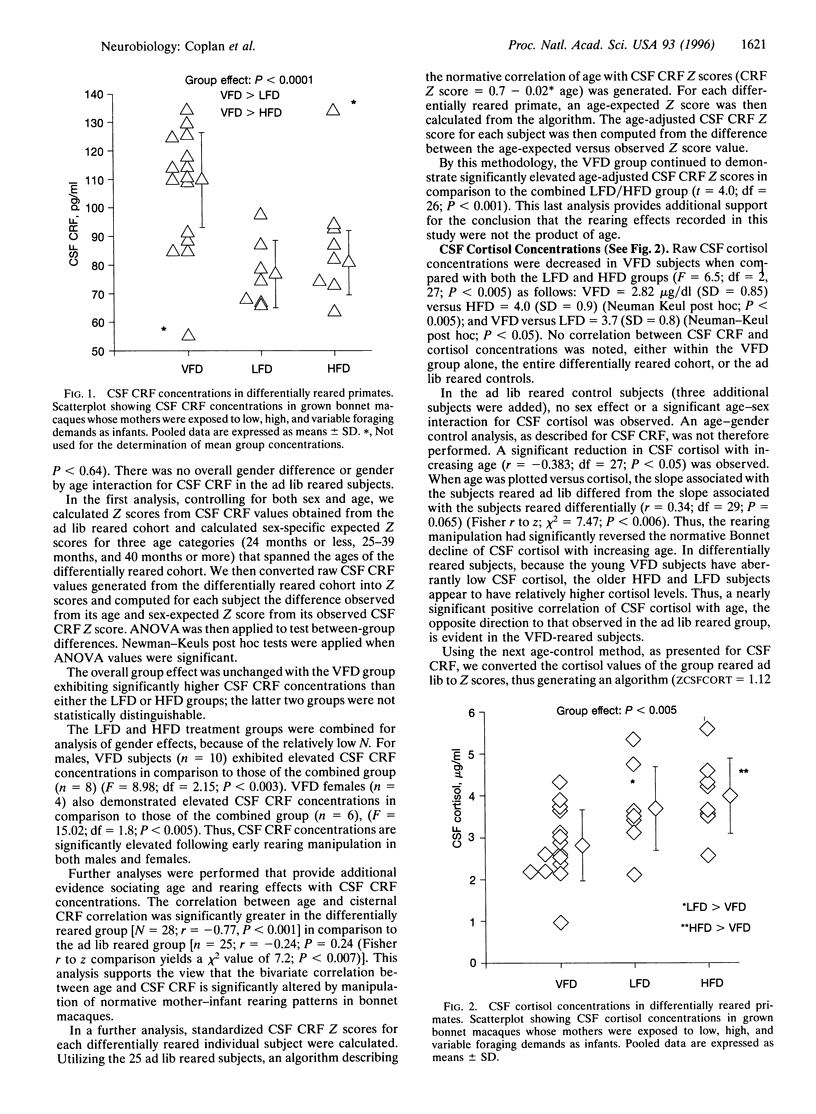
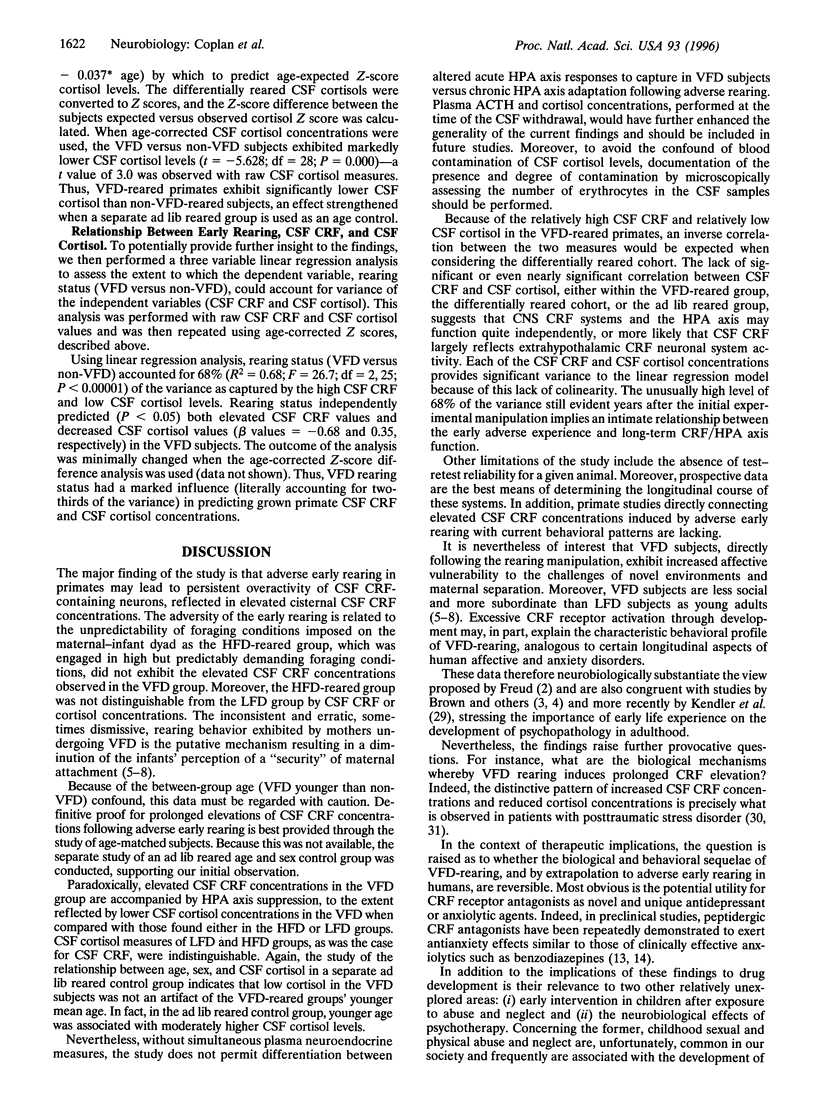
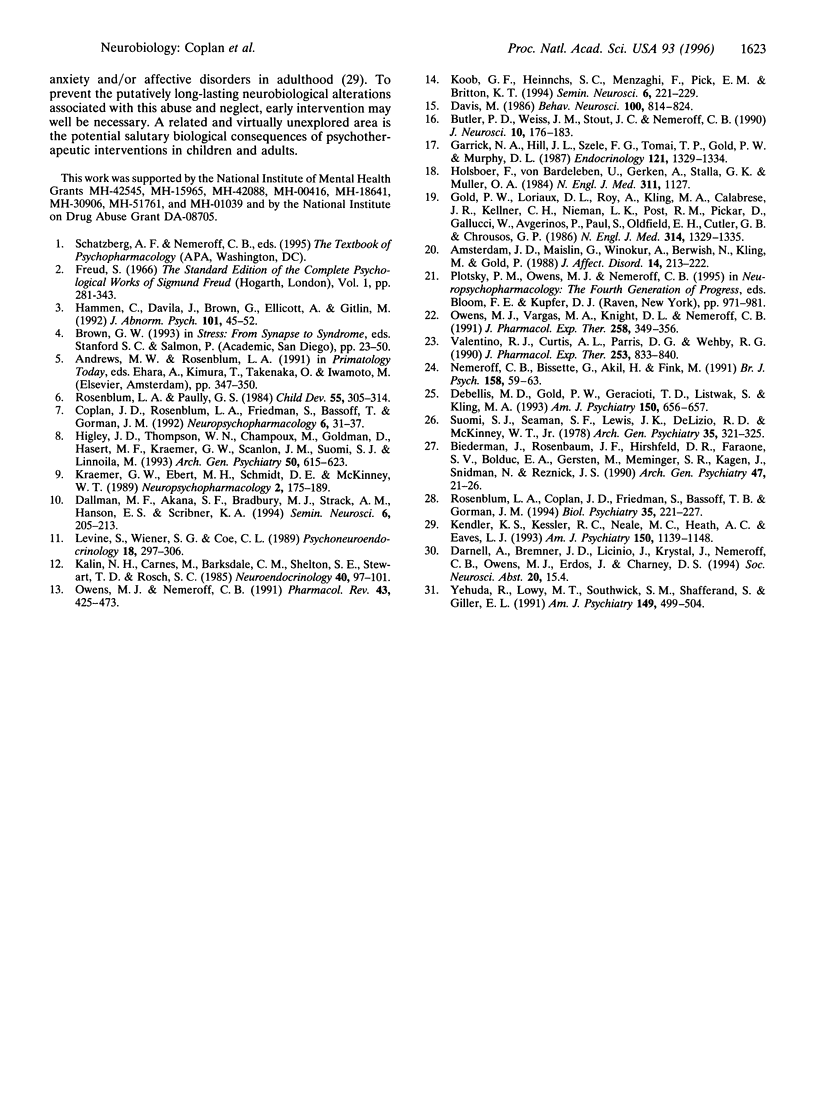
Selected References
These references are in PubMed. This may not be the complete list of references from this article.
- Amsterdam J. D., Maislin G., Winokur A., Berwish N., Kling M., Gold P. The oCRH stimulation test before and after clinical recovery from depression. J Affect Disord. 1988 May-Jun;14(3):213–222. doi: 10.1016/0165-0327(88)90037-7. [DOI] [PubMed] [Google Scholar]
- Biederman J., Rosenbaum J. F., Hirshfeld D. R., Faraone S. V., Bolduc E. A., Gersten M., Meminger S. R., Kagan J., Snidman N., Reznick J. S. Psychiatric correlates of behavioral inhibition in young children of parents with and without psychiatric disorders. Arch Gen Psychiatry. 1990 Jan;47(1):21–26. doi: 10.1001/archpsyc.1990.01810130023004. [DOI] [PubMed] [Google Scholar]
- Butler P. D., Weiss J. M., Stout J. C., Nemeroff C. B. Corticotropin-releasing factor produces fear-enhancing and behavioral activating effects following infusion into the locus coeruleus. J Neurosci. 1990 Jan;10(1):176–183. doi: 10.1523/JNEUROSCI.10-01-00176.1990. [DOI] [PMC free article] [PubMed] [Google Scholar]
- Coplan J. D., Rosenblum L. A., Friedman S., Bassoff T. B., Gorman J. M. Behavioral effects of oral yohimbine in differentially reared nonhuman primates. Neuropsychopharmacology. 1992 Jan;6(1):31–37. [PubMed] [Google Scholar]
- Davis M. Pharmacological and anatomical analysis of fear conditioning using the fear-potentiated startle paradigm. Behav Neurosci. 1986 Dec;100(6):814–824. doi: 10.1037//0735-7044.100.6.814. [DOI] [PubMed] [Google Scholar]
- De Bellis M. D., Gold P. W., Geracioti T. D., Jr, Listwak S. J., Kling M. A. Association of fluoxetine treatment with reductions in CSF concentrations of corticotropin-releasing hormone and arginine vasopressin in patients with major depression. Am J Psychiatry. 1993 Apr;150(4):656–657. doi: 10.1176/ajp.150.4.656. [DOI] [PubMed] [Google Scholar]
- Garrick N. A., Hill J. L., Szele F. G., Tomai T. P., Gold P. W., Murphy D. L. Corticotropin-releasing factor: a marked circadian rhythm in primate cerebrospinal fluid peaks in the evening and is inversely related to the cortisol circadian rhythm. Endocrinology. 1987 Oct;121(4):1329–1334. doi: 10.1210/endo-121-4-1329. [DOI] [PubMed] [Google Scholar]
- Gold P. W., Loriaux D. L., Roy A., Kling M. A., Calabrese J. R., Kellner C. H., Nieman L. K., Post R. M., Pickar D., Gallucci W. Responses to corticotropin-releasing hormone in the hypercortisolism of depression and Cushing's disease. Pathophysiologic and diagnostic implications. N Engl J Med. 1986 May 22;314(21):1329–1335. doi: 10.1056/NEJM198605223142101. [DOI] [PubMed] [Google Scholar]
- Hammen C., Davila J., Brown G., Ellicott A., Gitlin M. Psychiatric history and stress: predictors of severity of unipolar depression. J Abnorm Psychol. 1992 Feb;101(1):45–52. doi: 10.1037//0021-843x.101.1.45. [DOI] [PubMed] [Google Scholar]
- Higley J. D., Thompson W. W., Champoux M., Goldman D., Hasert M. F., Kraemer G. W., Scanlan J. M., Suomi S. J., Linnoila M. Paternal and maternal genetic and environmental contributions to cerebrospinal fluid monoamine metabolites in rhesus monkeys (Macaca mulatta). Arch Gen Psychiatry. 1993 Aug;50(8):615–623. doi: 10.1001/archpsyc.1993.01820200025003. [DOI] [PubMed] [Google Scholar]
- Holsboer F., Von Bardeleben U., Gerken A., Stalla G. K., Müller O. A. Blunted corticotropin and normal cortisol response to human corticotropin-releasing factor in depression. N Engl J Med. 1984 Oct 25;311(17):1127–1127. doi: 10.1056/NEJM198410253111718. [DOI] [PubMed] [Google Scholar]
- Kalin N. H., Carnes M., Barksdale C. M., Shelton S. E., Stewart R. D., Risch S. C. Effects of acute behavioral stress on plasma and cerebrospinal fluid ACTH and beta-endorphin in rhesus monkeys. Neuroendocrinology. 1985 Feb;40(2):97–101. doi: 10.1159/000124061. [DOI] [PubMed] [Google Scholar]
- Kendler K. S., Kessler R. C., Neale M. C., Heath A. C., Eaves L. J. The prediction of major depression in women: toward an integrated etiologic model. Am J Psychiatry. 1993 Aug;150(8):1139–1148. doi: 10.1176/ajp.150.8.1139. [DOI] [PubMed] [Google Scholar]
- Kraemer G. W., Ebert M. H., Schmidt D. E., McKinney W. T. A longitudinal study of the effect of different social rearing conditions on cerebrospinal fluid norepinephrine and biogenic amine metabolites in rhesus monkeys. Neuropsychopharmacology. 1989 Sep;2(3):175–189. doi: 10.1016/0893-133x(89)90021-3. [DOI] [PubMed] [Google Scholar]
- Levine S., Wiener S. G., Coe C. L. Temporal and social factors influencing behavioral and hormonal responses to separation in mother and infant squirrel monkeys. Psychoneuroendocrinology. 1993;18(4):297–306. doi: 10.1016/0306-4530(93)90026-h. [DOI] [PubMed] [Google Scholar]
- Nemeroff C. B., Bissette G., Akil H., Fink M. Neuropeptide concentrations in the cerebrospinal fluid of depressed patients treated with electroconvulsive therapy. Corticotrophin-releasing factor, beta-endorphin and somatostatin. Br J Psychiatry. 1991 Jan;158:59–63. doi: 10.1192/bjp.158.1.59. [DOI] [PubMed] [Google Scholar]
- Owens M. J., Nemeroff C. B. Physiology and pharmacology of corticotropin-releasing factor. Pharmacol Rev. 1991 Dec;43(4):425–473. [PubMed] [Google Scholar]
- Owens M. J., Vargas M. A., Knight D. L., Nemeroff C. B. The effects of alprazolam on corticotropin-releasing factor neurons in the rat brain: acute time course, chronic treatment and abrupt withdrawal. J Pharmacol Exp Ther. 1991 Jul 1;258(1):349–356. [PubMed] [Google Scholar]
- Rosenblum L. A., Coplan J. D., Friedman S., Bassoff T., Gorman J. M., Andrews M. W. Adverse early experiences affect noradrenergic and serotonergic functioning in adult primates. Biol Psychiatry. 1994 Feb 15;35(4):221–227. doi: 10.1016/0006-3223(94)91252-1. [DOI] [PubMed] [Google Scholar]
- Rosenblum L. A., Paully G. S. The effects of varying environmental demands on maternal and infant behavior. Child Dev. 1984 Feb;55(1):305–314. [PubMed] [Google Scholar]
- Suomi S. J., Seaman S. F., Lewis J. K., DeLizio R. D., McKinney W. T., Jr Effects of imipramine treatment of separation-induced social disorders in rhesus monkeys. Arch Gen Psychiatry. 1978 Mar;35(3):321–325. doi: 10.1001/archpsyc.1978.01770270071006. [DOI] [PubMed] [Google Scholar]
- Valentino R. J., Curtis A. L., Parris D. G., Wehby R. G. Antidepressant actions on brain noradrenergic neurons. J Pharmacol Exp Ther. 1990 May;253(2):833–840. [PubMed] [Google Scholar]
- Yehuda R., Lowy M. T., Southwick S. M., Shaffer D., Giller E. L., Jr Lymphocyte glucocorticoid receptor number in posttraumatic stress disorder. Am J Psychiatry. 1991 Apr;148(4):499–504. doi: 10.1176/ajp.148.4.499. [DOI] [PubMed] [Google Scholar]


